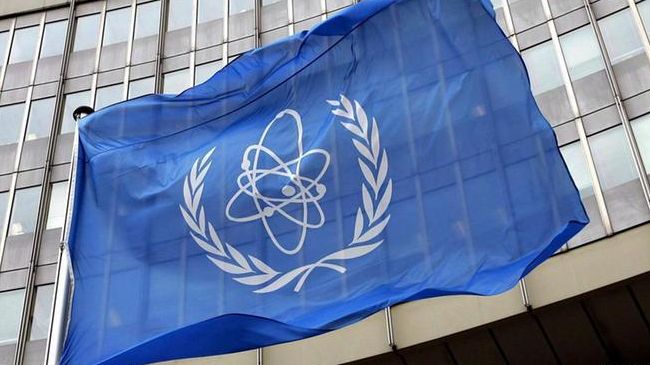 TEHRAN (FNA)- A team of International Atomic Energy Agency (IAEA) inspectors is slated to arrive in Tehran on Sunday to meet with senior Iranian nuclear officials and visit the country's nuclear facilities in accordance to the agreement signed by the UN nuclear watchdog agency and the Atomic Energy Organization of Iran in November.
TEHRAN (FNA)- A team of International Atomic Energy Agency (IAEA) inspectors is slated to arrive in Tehran on Sunday to meet with senior Iranian nuclear officials and visit the country's nuclear facilities in accordance to the agreement signed by the UN nuclear watchdog agency and the Atomic Energy Organization of Iran in November.The IAEA inspectors are scheduled to meet AEOI officials on Monday before their travel to Yazd province to visit Saghand uranium mine in Yazd province in Central Iran and Ardakan Yellowcake production - uranium ore concentrate processing - plant in the same province.
The IAEA inspectors will leave Tehran for Vienna on Tuesday night.
Earlier this week, AEOI Spokesman Behrouz Kamalvandi informed that a team of IAEA inspectors to be headed by chief inspector Massimo Aparo is due to visit a uranium ore concentrate processing plant and a uranium mine in Iran this week.
"IAEA Deputy Director General Massimo Aparo, who also heads the international body's inspectors, will travel to Iran next (Iranian) week to visit Saghand uranium mine and Ardakan processing plant," Kamalvandi told FNA on Tuesday.
He said that the visit would take place in line with a joint agreement signed on November 11 by Head of the AEOI Ali Akbar Salehi and IAEA Director General Yukiya Amano on mutual cooperation.
Kamalvandi said that an IAEA delegation had also traveled to Iran a few days earlier within the framework of cooperation between Iran and the UN nuclear watchdog.
Noting that Iran and the IAEA officials have had reciprocal visits in recent months, he said, "Issues related to the six-paragraph and the seven-step procedural agreements signed by Iran and the IAEA were the main subject of these negotiations."
The remarks came after the UN nuclear watchdog said on Monday its chief inspector had held "informal" talks in Tehran.
The IAEA gave no details about the previously unannounced visit of Aparo to the Iranian capital.
He went to Tehran "at the end of last week for informal talks as part of regular contacts between the agency and Iran," IAEA Spokesman Serge Gas said in an email to Reuters last week.
Gas said Amano would "provide an update on developments" in Iran to the UN agency's 35-nation board of governors in a few weeks' time, an apparent reference to a quarterly report due in May.
The visit took place in line with a joint agreement signed between the AEOI and IAEA.
The agreement allows the IAEA inspectors to voluntarily visit Arak heavy water plant in central Iran and Gachin mine in Bandar Abbas.
Iran announced in late January that inspectors of the IAEA had paid a visit to Gachin uranium mine in Southern Iran.
The inspectors of the IAEA also visited Arak heavy water facilities in December.
On February 8, the AEOI and the IAEA released a 7-article MoU on continued cooperation in the future.
The agreement contains Iran's voluntary cooperation untouched in the November Iran-IAEA agreement, known as the Tehran Declaration, in the form of the joint plan of action signed in late November between Iran and the Group 5+1 (the five permanent UN Security Council members plus Germany). The agreement included Tehran's voluntary cooperation in:
1-Providing (the IAEA) with administered access to Yazd�s Saqand Mine and the information agreed by the two sides,
2-Providing (the IAEA) with administered access to Ardakan enrichment facility the information agreed by the two sides,
3-Submitting updated design information questionnaire (DIQ) of Arak�s IR-40 reactor,
4-Adopting measures to materialize safeguard approach for Arak�s IR-40 reactor,
5-Arranging technical visit to Lashkarabad Laser Center and providing (the IAEA) with the information agreed by the two sides,
6-Providing source material, that has not reached the necessary composition and purity for making fuel or enrichment, including import of such material to Iran and extraction of uranium from phosphate by Iran,
7-Providing information and explanations to the IAEA to evaluate Iran�s statement on the need or application of Electron Bernstein waves (EBW) (new generation of safe fuses).
Two days later on February 10, AEOI Spokesman Behrouz Kamalvandi underlined that inspection of Iran's military sites was no part of the Tehran 7-Article agreement struck between the AEOI and the IAEA.
�Inspection of Parchin (military site) is not within the framework of these seven steps,� Kamalvandi told reporters in Tehran in February.
By Fars News Agency
The Iran Project is not responsible for the content of quoted articles.










